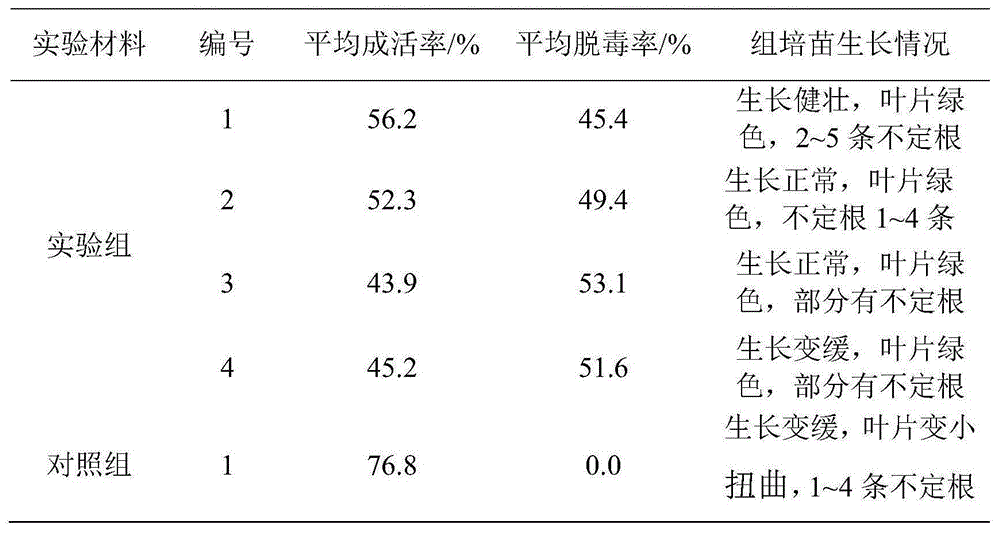Rapid propagation method of cassava virus-free seedlings
A technology of virus-free seedlings and cassava, applied in horticultural methods, botanical equipment and methods, horticulture, etc., can solve the problem of hindering the introduction and exchange of high-quality cassava germplasm resources, affecting the large-scale promotion of virus-free seedlings, and the reproductive efficiency of virus-free seedlings Low-level problems, to achieve a significant detoxification effect, reduce the cost of seedling cultivation, and shorten the effect of the cultivation period
- Summary
- Abstract
- Description
- Claims
- Application Information
AI Technical Summary
Problems solved by technology
Method used
Image
Examples
Embodiment 1
[0026] A kind of cassava virus-free seedling rapid multiplication method, its steps are:
[0027] 1. Explant collection and pretreatment: Use a blade to cut cassava shoots of 2 to 3 cm as explants, cut off the larger young leaves, rinse with tap water for several minutes, rinse clean, use absorbent paper to dry the surface water or Dry naturally; put the shoot explants in a constant temperature box, and treat them at 50°C for 1 hour to complete the detoxification pretreatment of the explants;
[0028] 2. Surface disinfection of explants and stripping of stem tips: Soak in 75% alcohol solution by volume for 10 seconds on the ultra-clean workbench, rinse once with sterile water, and then disinfect with 0.1% mercury chloride solution by weight for 3 minutes. Rinse with sterile water for 4 times, and absorb the surface moisture with sterilized paper; under aseptic conditions, peel off the young leaves covered by the shoots layer by layer from the outside to the inside of the surfa...
Embodiment 2
[0033] A kind of cassava virus-free seedling rapid multiplication method, its steps are:
[0034] 1. Explant collection and pretreatment: Cut off 2-3cm cassava shoots with a knife, cut off the larger young leaves, wash with tap water and dry the surface moisture; then place in a constant temperature box at 55°C Treat 1.5h to complete explant detoxification pretreatment;
[0035] 2. Surface disinfection of explants and stripping of stem tips: Soak the explants in step 1 with alcohol with a volume concentration of 75% for 15 seconds on an ultra-clean workbench, rinse twice with sterile water, and then disinfect with 0.1% mercuric chloride For 4 minutes, wash with sterile water 5 times, and sterilize the paper to dry the surface moisture; peel off the meristem area length of 0.4-0.5mm with 1-2 leaf primordia shoot tips under a binocular dissecting microscope;
[0036] 3. Shoot tip induction culture: the shoot tip cut off in step 2 is inoculated into the shoot tip induction mediu...
Embodiment 3
[0040] A kind of cassava virus-free seedling rapid multiplication method, its steps are:
[0041] 1. Explant collection and pretreatment: Select cassava plants, cut off the 2-3cm shoots, cut off the larger leaves, rinse with tap water, absorb the surface moisture with absorbent paper or dry naturally; then The buds were placed in an incubator at 60°C for 3 hours to complete the detoxification pretreatment of the explants;
[0042] 2. Surface disinfection of explants and stripping of stem tips: Soak the explants in step 1 with 75% alcohol for 15 seconds on an ultra-clean workbench, rinse them twice with sterile water, and then use 0.1% mercuric chloride Sterilize for 5 minutes, wash with sterile water 5 times, and blot the surface moisture with sterile paper; peel off the shoot tip with 1 to 2 leaf primordia in the meristem region with a length of 0.4 to 0.5 mm under a binocular dissecting microscope;
[0043] 3. Shoot tip induction culture: the shoot tip cut off in step 2 is ...
PUM
 Login to View More
Login to View More Abstract
Description
Claims
Application Information
 Login to View More
Login to View More - R&D
- Intellectual Property
- Life Sciences
- Materials
- Tech Scout
- Unparalleled Data Quality
- Higher Quality Content
- 60% Fewer Hallucinations
Browse by: Latest US Patents, China's latest patents, Technical Efficacy Thesaurus, Application Domain, Technology Topic, Popular Technical Reports.
© 2025 PatSnap. All rights reserved.Legal|Privacy policy|Modern Slavery Act Transparency Statement|Sitemap|About US| Contact US: help@patsnap.com

